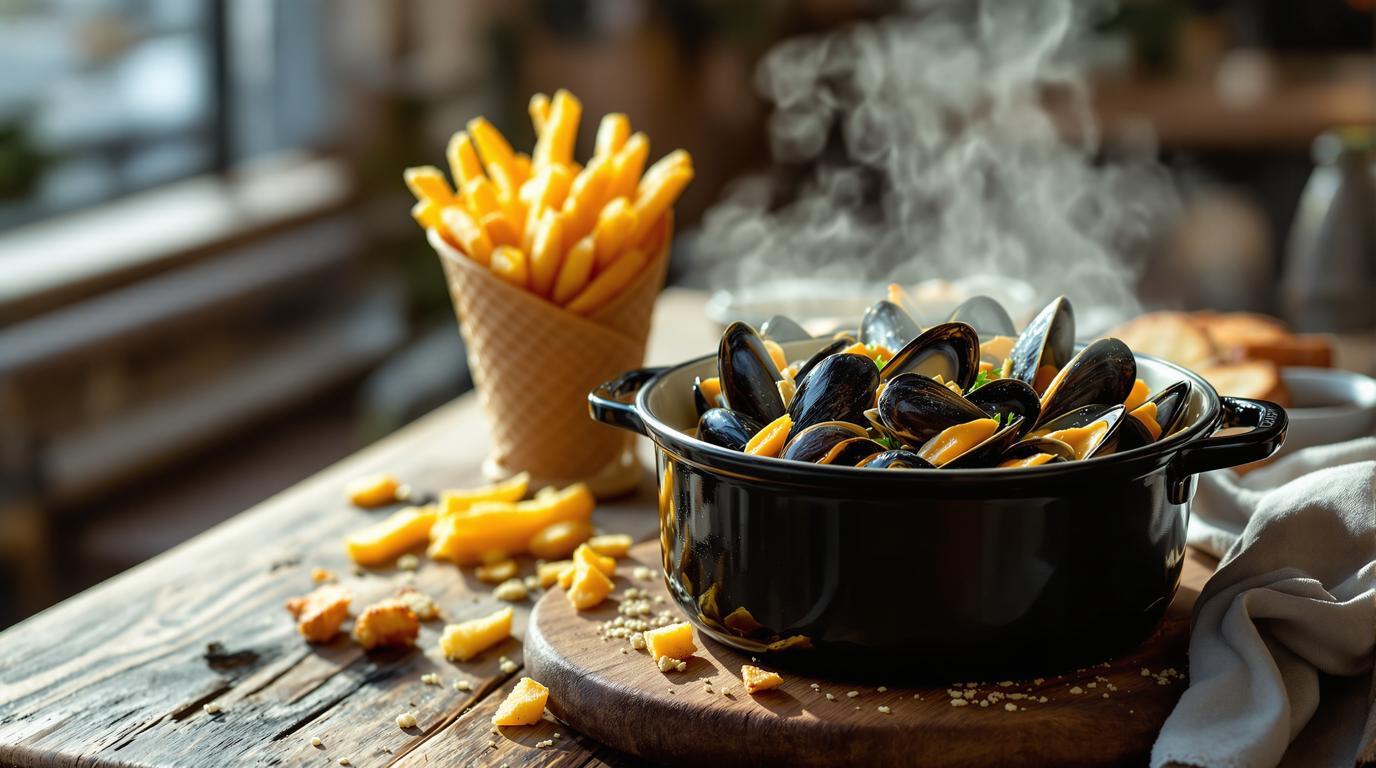I still remember the first time I encountered moules-frites in a small seaside bistro in Brussels. The steam rising from the pot as the waiter placed it before me, the intoxicating aroma of white wine and garlic, and that first incredible bite of plump mussel dipped in the briny sauce – pure magic. While Belgium claims this dish as its national treasure, few know it only gained international recognition after the 1958 Brussels World’s Fair, where visitors fell in love with this perfect marriage of land and sea flavors.
Classic Moules-Frites: The Belgian Soul Dish 🇧🇪
Moules-frites sits at the heart of Belgian culinary identity – a deceptively simple dish that exemplifies the beauty of restraint. The classic preparation allows the sweet brininess of mussels to shine while the crispy frites provide textural contrast. Over my decades in professional kitchens, I’ve found the “revisités” (reimagined) approach respects tradition while introducing subtle contemporary elements.
Having traveled extensively through Belgium’s coastal regions, I’ve learned that authentic moules-frites isn’t about complicated techniques – it’s about precision timing and quality ingredients. The fishermen I’ve befriended along Belgium’s coast insist that mussels should be cooked within hours of harvesting, a luxury few of us have, but freshness remains paramount.
Essential Ingredients 🧾
For the mussels (serves 4):
• 3-4 pounds (1.5 kg) fresh mussels, scrubbed and debearded
• 2 tablespoons (30g) unsalted butter
• 2 medium shallots, finely chopped (about ¼ cup)
• 2 cloves garlic, minced
• ⅔ cup (150ml) dry white wine (Sauvignon Blanc works beautifully)
• 1 tablespoon fresh flat-leaf parsley, chopped
• Sea salt and freshly ground black pepper
• Optional: 1 teaspoon Dijon mustard
For the frites:
• 2 pounds (900g) russet potatoes, peeled and cut into ½-inch batons
• 2 quarts (2L) neutral oil for frying
• Maldon sea salt
The Perfect Moules: Step-by-Step 📝
1. Prepare the mussels: Soak them in cold water for 20 minutes. Scrub the shells, remove the “beards” (the fibrous strands hanging from the shells), and discard any open mussels that don’t close when tapped.
2. Build the flavor base: In a large pot with a tight-fitting lid, melt the butter over medium heat. Add the shallots and sweat until translucent but not browned, about 3 minutes. Add the garlic and cook for 30 seconds until fragrant.
3. Create the steam bath: Pour in the white wine and bring to a simmer for 2 minutes to burn off the alcohol. Season with a pinch of salt and pepper.
4. Steam with precision: Add the mussels to the pot, increase the heat to high, and cover. Steam for 3-5 minutes, shaking the pot occasionally, until most mussels have opened. Avoid overcooking – once they open, they’re done!
Chef’s Note: The magical transformation happens in those 3-5 minutes of steaming. The mussels release their briny juices, which combine with the wine and aromatics to create a sauce more complex than the sum of its parts. This natural alchemy is why I’ve always been fascinated by this dish – it creates itself!
5. Finish with finesse: Remove from heat, discard any unopened mussels, and gently stir in the parsley. For my “revisités” touch, whisk in a teaspoon of Dijon mustard – a subtle addition that amplifies the wine’s acidity and adds depth.
Perfect Frites: The Belgian Way 🍟
The secret to authentic Belgian frites is double-frying – a technique I learned from a third-generation frites maker in Bruges:
1. First fry: Heat oil to 325°F (160°C). Fry potatoes in batches for 4-5 minutes until they’re cooked through but still pale. Remove and drain on paper towels. Let rest for 15 minutes.
2. Second fry: Increase oil temperature to 375°F (190°C). Return potatoes to oil in batches and fry until deeply golden and crispy, about 2-3 minutes. Drain and immediately season with Maldon salt.
Can’t commit to deep-frying? Try my oven-roasted method – not traditional, but respectably delicious.
Serving: A Communal Ritual 🍽️
In Belgium, moules-frites is more than a meal – it’s a social experience. Serve the mussels in their cooking pot at the center of the table with frites on the side. Provide empty shells for discarding spent shells and warm, crusty bread for sopping up the precious broth.
If you enjoy this classic Belgian dish, you might also appreciate the depth of flavor in my slow-cooked pork bao or the comfort of French winter vegetable stew.
For dessert, I’d suggest my grandmother’s cream puffs – their light texture provides the perfect counter to the rich mussels.
Start tomorrow with Swiss-inspired overnight apple oats, or explore authentic Korean flavors for your next culinary adventure.
Remember, moules-frites is about celebrating simplicity and letting quality ingredients speak for themselves. There’s poetry in this humble dish that continues to captivate me after two decades of professional cooking. I hope it brings the same joy to your table. 🍽️
